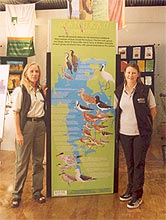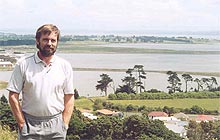 |
|

|
Protection
of precious wetlands - success in New
Zealand
by
Kim Blazey from IFAW
and MESA NSW Rep |
| As
people across the globe celebrated World
Wetlands Day on 2 February, New Zealand
should be very proud of its achievements
in protecting vulnerable wetlands. The
International Fund for Animal Welfare
(IFAW) supports the Mangere Mountain
Education Centre by funding an information
display which helps in its vital work
encouraging the protection of the Manukau
Harbour Wetlands for its wide variety
of water or wading birds.
The
Mangere Sewage treatment plant and
particularly the oxidation ponds covered
500ha of Manukau Harbour since 1960.
Through new processes developed to
deal with waste the ponds were no
longer needed. In May 2001 the sea
walls were knocked down and the tide
was allowed to flow in. This redevelopment
has meant more mudflats for the birds
to feed on. Rejuvenating roost sites
away from the nearby Auckland airport,
avoids birds roosting in areas of
short grass near runway tarmacs.
This
largest coastal marine restoration
project in New Zealand leads an example
to the rest of the world. Migratory
birds and their habitat are under
threat globally. Asia hosts vital
staging sites in the birds long migration
from the high Arctic, a journey of
approximately 11,000kms. Long distance
migrant waders habitats are in danger
by huge population pressures. These
are becoming destroyed by land-claim,
poor management, and natural resources
exploitation.
|

Annie
Wheeler, DOC and Kim Blazey
IFAW with the IFAW Waderbird display. |
| |
|
| Every
spring 200,000 wader birds arrive in
New Zealand from the high Arctic, a
journey of approximately 11,000kms,
and thousands of them spend the summer
on the Manukau, Firth of Thames and
other wetlands throughout New Zealand.
"The Manukau is a very special
place. It is our responsibility to respect
the Harbour and the natural life within
and around it," says Keith Woodley,
Manager of the Miranda Shorebird Centre.
"By protecting wetlands, we help
to ensure migratory birds will always
find a haven at the end of their epic
journeys."
The
Mangere Mountain Education Centre
worked closely with the Department
of Conservation and IFAW to make a
display that educates people on the
multitude of birds, migratory routes
and the history of the rejuvenation
of the Harbour. Mick McIntyre, IFAW
Asia Pacific Director, highlighted
the importance of partnerships in
preserving delicate wetland areas.
"It is important we work together
to protect the fragile ecosystems
of the wetlands and remain vigilant
towards the many threats to wader
bird habitats such as development,
stormwater, industrial pollution and
other disturbances including dogs,
machinery and people, " he said.
|

Keith
Woodley - Shorebird Centre Manager,
Miranda,
New Zealand, Manukau Harbour. |
| |
|
| Not
far from Auckland Airport, the centre
is a great place to visit and learn
about the local environment, history
and culture and the Mangere Mountains
spiritual significance to Tangata Whenua.
For further information visit www.mangeremountain.co.nz.
|
|
|
|
|
|
